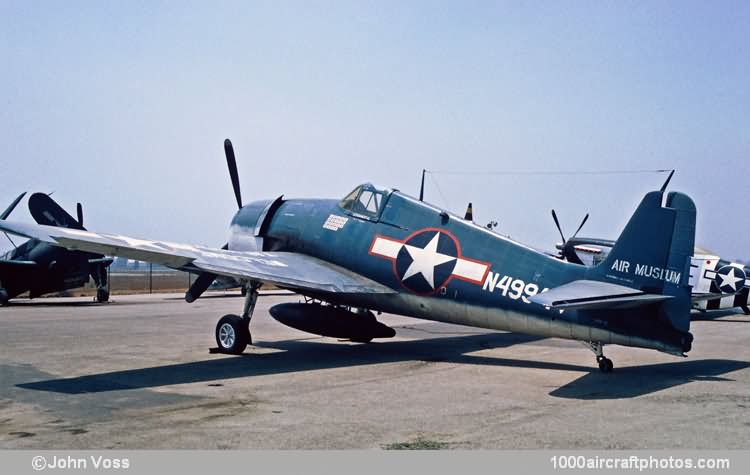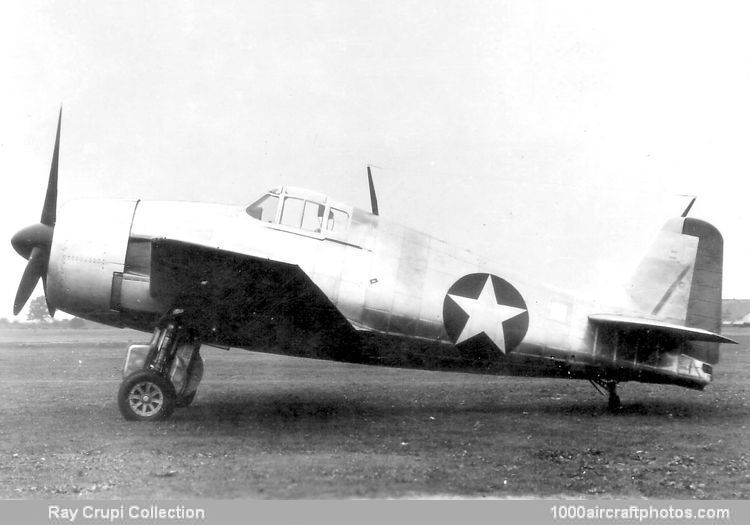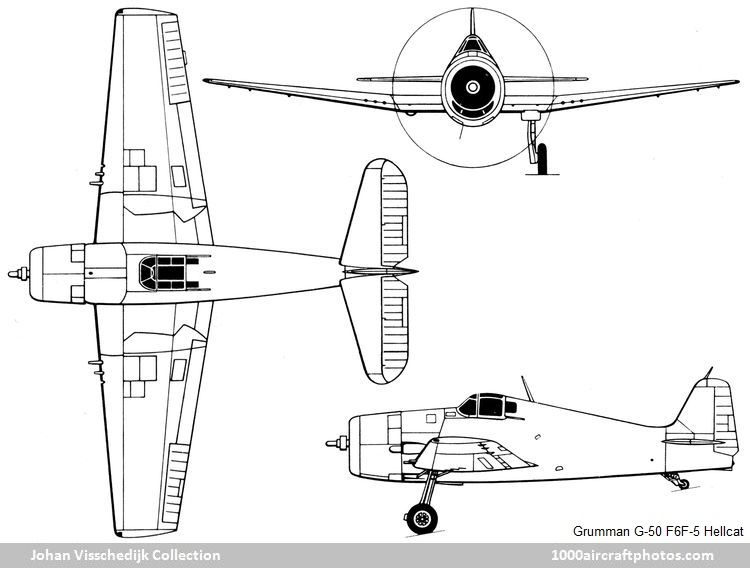Photographed at Planes of Fame, Chino, California, USA, ca. 1965, by John Voss
Grumman G-50 XF6F-1 Hellcat (02981) (
Ray Crupi Collection)
Designated XF6F-1, this had been ordered by the USN on June 30, 1941 as a potential successor to the
Grumman F4F Wildcat. Powered by an 1,600 hp Wright R-2600 Cyclone engine, the XF6F-1 flew on June 26, 1942, but the modifications considered necessary in the light of operational experience during the opening stages of the Pacific War resulted in the designation of the second prototype being changed to XF6F-3 while still under construction, the XF6F-2 being a proposed version with a turbocharged R-2600 engine.
The XF6F-3 was flown for the first time on July 30, 1942, with a Pratt and Whitney R-2800 Double Wasp. The speed with which Grumman attained production can be gauged from the fact that the first
F6F-3 flew on October 4, 1942, ten Hellcats having been completed by the end of the year. The XF6F-3 was powered by an R-2800-10 Double Wasp developing 2,000 hp for take off and 1,975 hp at 16,900 ft (5,151 m). Its normal loaded weight was 12,740 lb (5,779 kg), and maximum speeds of 315 mph (507 kmh) at sea level and 380 mph (612 kmh) at 23,400 ft (7,132 m) were attained. Provision was made for an armament of six 0.50 in (12.7 mm) wing-mounted guns with 400 rounds per gun.
The production F6F-3 differed from the prototype in minor details only, the main landing gear fairings being redesigned, the airscrew spinner being removed and a Hamilton Standard Hydromatic airscrew supplanting the Curtiss Electric unit. The first
F6F-3s assigned to fleet units were received by VF-9 on January 16, 1943 aboard the USS Essex, and the first use of the Hellcat in combat was made by VF-5 operating from the USS Yorktown during an attack on Marcus Island on August 31, 1943 – a mere eighteen months after the prototype's first flight!
From this date, the Hellcat rapidly replaced the Wildcat on board the principal US carriers and was destined to remain the standard fighter of the fast carrier force throughout the remainder of the war, the introduction of the Corsair to fast carrier operations in December 1944 supplementing rather than replacing the employment of the Grumman fighter in the final campaigns of the war.
The F6F-3 Hellcat, 2,545 examples of which were delivered during 1943, was similarly powered to the prototype, and 252 examples were supplied to Britain as the Hellcat I under Lend-Lease, first seeing service with the Fleet Air Arm (FAA) in July 1943 with No. 800 Squadron which took the type onto operations from the light escort carrier Emperor in December during anti-shipping strikes off the Norwegian coast. The Hellcat's subsequent service with the FAA was primarily in the Far East. Night fighter variants were the F6F-3E with APS-4 radar and the F6F-3N with APS-6 housed in a pod beneath the starboard wing. Of the 4,423 F6F-3 Hellcats completed before production switched to the F6F-5 in April 1944, eighteen were F6F-3Es and 205 were F6F-3Ns.
The XF6F-2 had a turbocharged R-2800-21 engine installed in December 1943, flying with this in January 1944, and the airframe of the XF6F-1 was fitted with an R-2800-27 engine and flown on October 2, 1942 as the XF6F-4, but this model progressed no further than the prototype stage, the next production model of the Hellcat being the F6F-5 which flew for the first time on April 4, 1944.
The F6F-5 differed from its predecessor in having a redesigned engine cowling, improved windshield, new ailerons, strengthened tail surfaces and additional armor behind the pilot, increasing total weight of armor from 212 to 242 lb (96 to 110 kg). Two 1,000 lb (454 kg) bombs could be carried under the center section, provision was made for six 5 in (12.7 cm) rocket projectiles, and late production models could have 0.787 in (20 mm) cannon in place of the two inner 0.50 in (12.7 mm) machine guns. The power plant was an R-2800-10W similar to that installed in late production F6F-3s and capable of developing an emergency power of 2,200 hp by the use of water injection.
No fewer than 6,436 F6F-5s had been produced when manufacture terminated in November 1945, approximately one-sixth of these being F6F-5N night fighters. The FAA received 930 F6F-5s as Hellcat IIs, and a further eighty radar-equipped equivalents to the F6F-5N were delivered to the UK. Two FAA squadrons were formed with Hellcat N.F.Mk.IIs, Nos. 891 and 892, but neither saw operational service. Ten other FAA squadrons were operating Hellcat Is and IIs on V-J Day, mostly in the Far East.
One other version of the Hellcat was built, the XF6F-6 powered by the 2,100 hp R-2800-18W engine. The first of two examples of the XF6F-6 was flown on July 6, 1944, but no production was undertaken. A total of 12,274 Hellcats of all types was produced, and this fighter was credited with 4,947 of the 6,477 enemy aircraft destroyed in the air by USN carrier pilots. With the scores of shore-based Hellcat units, including USMC squadrons, added, this one lighter type was responsible for the destruction of no less than 5,156 enemy aircraft.
The pictured aircraft was built for the USN under BuNo. 93879 in 1944. After it was struck off charge it became part of the collection of Ed Maloney's Air Museum at Claremont, California, in 1958. In 1972 it was damaged in a landing accident at Elsinore Dry Lake, after being repaired it was sold to Planes Of Fame, Chino. On January 11, 2003, while in the circuit at Parker, Arizona, it collided with Cessna 182H, registered N8567S (c/n 182-56667). The substantially damaged Hellcat landed safely, the Cessna crashed, killing the two occupants.
The Hellcat was lost almost three years later, on October 8, 2005. En route from Sevierville, Tennessee to Little Rock, Arkansas, the Hellcat collided with power lines and fell to the ground and burst into flames. The pilot Art Vance received fatal injuries."



